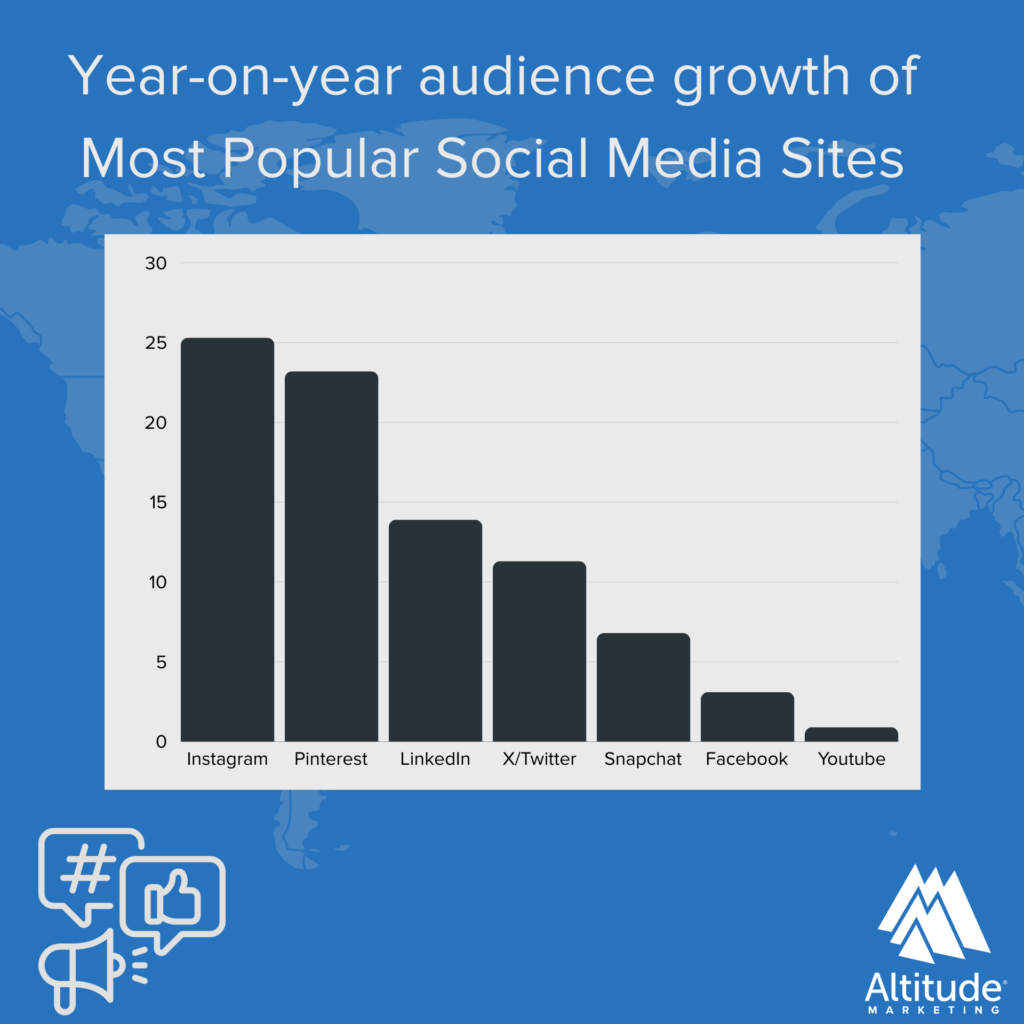Why is it so tough for manufacturing companies to get noticed on social media?
The answer is simple: without a clear strategy, it’s easy to get lost in the noise. While B2C brands grab attention with flashy posts, manufacturers often face low engagement and missed opportunities.
It’s time for you to rethink your approach and start using new strategies that can help them stand out, attract leads, and build better connections with potential clients and partners.

6 B2B Social Media Strategies for Manufacturing Companies
Why Social Media is Vital for Manufacturing Companies
For an industry that’s normally characterized by interpersonal contacts, exhibitions, and prolonged sales processes, social network participation is something that most manufacturing companies may find quite uncommon. Nonetheless, the present age requires participation for engagement.
About 5.04 billion globally use social media worldwide, making it very important for any business. There are now emerging methods in which manufacturers can tap known social sites to access key people, establish authority, and drive leads which has not been possible before.
Launching B2B Practices on Social Networking Sites: LinkedIn, Twitter, and even Facebook and Reddit specialized interest groups have turned out to be very important in B2B communications.
Brand Development and Recognition Using Social Media: Social networks present manufacturers with the necessary channels to market their competencies, new developments, and products in the respective industry. With the help of the core steps in building a brand and social media’s reach, you can effectively establish your company in the industry.
Availability of Forms for Lead Generation: Buyers are nowadays dependent upon social networks and professionals.
The first thing to do is to recognize the significance of social media. However, how are the manufacturing firms willing to penetrate this space and use it optimally?
Utilizing LinkedIn To Establish Itself As A Thought Leader
Though other social media sites see a higher number of user bases monthly, LinkedIn is the most popular with a focus on businesses. With the rise of LinkedIn, it has become the standard for B2B marketing in many areas, especially for the manufacturing sector which entails connecting with key decision-makers and propelling thought leadership. For any B2B marketing campaign, starting with LinkedIn is a great start.
Creating Thought Leadership Content: Write and distribute advanced professional content like articles, and white papers, and white papers or conduct research that answers questions on the industry’s challenges, destruction, or orbit shifting.
Engaging with Key Decision Makers: LinkedIn Groups and posts may facilitate direct communication with the senior management and decision-makers of other businesses.
Showcasing Case Studies And Success Stories: Provide details showing how manufacturing solutions in the company address a specific need or enhanced service than in different companies.
Using LinkedIn Ads for Precise Targeting: The advertising mechanism on LinkedIn makes it possible to be very specific on the kind of B2B advertising in relation to the title, field, and size of the organization.
In the same way, as LinkedIn is the main focus of B2B professionals, quite a number of other sites are equally important for driving engagement.
Using Video Social Media Platforms for Brand Building
Only Instagram and YouTube in their channels have the heavy duty of sustaining content in video form which acts as a part of the specific platform culture.
Manufacturing companies can leverage these platforms to showcase their technical expertise and connect with audiences in a visually engaging way.
Product Videos and Tutorials: Use YouTube for long videos showing how the product is put together, how it works, and how it is used in practice.
Showcasing Video Content and Recording Events: This is where Instagram gives more options to present factory processes, people, and events such as exhibitions via Stories, and Reels.
Creating a Portfolio of Project Work: The current epoch is that of what is referred to as visual imagery manufacturing, where it is easy to market products or projects via Instagram among other social networks
Video may be the most potent form of persuasive content, however, just plain videos will not build up a community.
Niche Online Communities for Maximizing Engagement and Involvement
Due to the fact that manufacturing businesses work in specific industries with a more technical audience, it is important to use online communities. Niche forums and hashtags focused on various subjects allow for detailed actions and targeting. Using industry forums, finding Facebook or LinkedIn groups relevant to the industry, and subreddits can help manufacturers to get leads to people who need help and will be willing to pay for it.
Online Communities about the Industry: Industrial communities exist online like Reddit r manufacturing or industry-related message boards or forums automotive a GETGLOBAL
Q&A Sessions: Creating polls, AMAs, and QA sessions in niche B2B groups and micro industries can help establish authority. Don’t overdo it but do it enough to create a presence. With enough time and effort, you can build up a reputation as an established industry leader.
Networking: Going through the same niche channels offers networking opportunities both locally and internationally within the same industry. This means more chances of collaboration with other businesses.
Using Paid Social Media Advertising for Targeted Outreach
Manufacturing companies often face the challenge of low engagement and ineffective lead generation due to complex products and limited social media expertise. To overcome these issues, paid social media advertising offers targeted solutions for reaching the right audience.
Improved Targeting for Complex B2B Audiences: Manufacturing firms can leverage platforms like LinkedIn and Twitter to target specific decision-makers, such as C-Suite Executives, Business Development Managers, and Procurement Professionals. LinkedIn’s advanced targeting allows manufacturers to focus ads based on job titles, industries, and company size, ensuring their content reaches the right professionals involved in purchasing decisions.
Customizing Ads to Simplify Complex Offerings: Paid social media ads can help simplify technical products by focusing on benefits rather than features. For example, manufacturing companies can create ads that highlight how their solutions improve efficiency or reduce costs, resonating more with Marketing Managers and Sales Teams who are concerned with clear business outcomes rather than complex specs.
Retargeting to Boost Engagement and Lead Conversion: Many manufacturers need help with generating meaningful leads from social media. Retargeting allows companies to serve ads to users who have previously engaged with their content, such as visiting the website or downloading a brochure. This ensures potential leads remain engaged, increasing the likelihood of conversion and helping Sales Teams connect with decision-makers more effectively.
Measuring ROI with Precise Analytics: For manufacturing firms that struggle with limited analytics and ROI measurement, platforms like LinkedIn offer detailed reporting tools. These allow companies to track campaign performance, analyze engagement, and fine-tune targeting to maximize return on investment, ensuring that their social media strategies are aligned with overall business goals.
Measure Social Media ROI:
Now that we have seen some common challenges in social media engagement, it’s time to determine the success of our campaign. Determining the social media marketing ROI in the manufacturing industry can be more burdensome than that of the consumer industry. Compared to B2C metrics, B2B social media success is harder to track. Rarely will a company engage in another post unless there is a collaboration. Individual employees working for the company can and do engage with other businesses.
To track success, the campaign must have to keep the right indicators, employ the right instruments, and correspond the social media platform to the actual commercial results.
Step 1: Define Your Objectives
The first step in any tracking and analytics process is to define goals. Are you looking to enhance the recognition of your brand? Attract more customers? Get more visitors to your site? The metrics that you monitor will be determined by these objectives. Here are some of the common objectives that are often put in place:
- Increasing brand recognition
- Creating quality leads
- Increasing the number of visitors on landing pages or product pages
- Establishing a leader in thoughts in the market
Step 2: Configure Analytical Tools
You will have to install tools such as Google Analytics, LinkedIn Insight, and YouTube Analytics to keep track of performance. These tools enable you to evaluate the amount of users who were directed to the website via social media, the effectiveness of doing the posting, and how the audience responded to the post.
- In the case of Google Analytics: UTM Tagging can be done to URLs of the social media posts and it enables you to find out where the traffic to your site is coming from.
- Social Media Insights: Most of the popular Social Media handles, amongst them LinkedIn, Instagram, and YouTube have internal analysis software that gives analytics of posts, audience engagement and other analytical feedback.
Tracking consumer sentiment can help gauge the effectiveness of B2B marketing campaigns. Though not the direct target, user engagement can offer insight into how established your brand is as an industry leader.
Step 3: Measure Important Metrics
Select relevant metrics that matter the most for your objectives. In case you want to build brand awareness, the important metrics are followers, impressions, engagement, etc. On the contrary, if lead generation is your goal, you should look at click rate, forms submitted, and conversions.
Likes, comments, shares, and mentions are regarded as engagement metrics that assist in finding out how the target audience. Finally, conduct a competitive marketing analysis and track the metrics of competitors to see how effective current campaigns are overall.
User-Generated Content (UGC) and Employee Advocacy
Manufacturing companies often find it difficult to showcase complex products in a way that resonates with broader audiences. By leveraging User-Generated Content (UGC) and Employee Advocacy, they can create more authentic, relatable, and engaging content, which is key to boosting brand awareness and overcoming low engagement.
1. Showcasing Products Through UGC: Encouraging customers to share real-world applications of products on platforms like LinkedIn or Instagram can help Marketing Managers bridge the gap between technical complexity and audience engagement. For instance, clients could share posts demonstrating how manufacturing solutions improve supply chain efficiency or production quality, providing social proof that resonates with Business Development Managers and Procurement Professionals.
2. Building Trust Through Employee Advocacy: Many manufacturers face the issue of misalignment between sales and marketing. By empowering employees, especially Sales Teams and Product Experts, to share their experiences and insights, companies can humanize their brand and create a consistent, authentic presence online. Employees can share behind-the-scenes content or success stories that highlight both the technical prowess of the company and its human side, which can appeal to decision-makers such as C-Suite Executives.
3. Engaging Broader Audiences with Visual UGC: Manufacturing firms often struggle to create visually appealing content. However, customer-submitted visuals, such as images or videos of products in action, can add an element of authenticity and help showcase the value of the products. These posts can be repurposed across various platforms, allowing Social Media Managers to easily build engagement while Marketing Managers can use them to enhance brand visibility.
4. Strengthening Industry-Specific Messaging: By encouraging both UGC and employee advocacy, manufacturing companies can stay up-to-date with industry-specific trends like video marketing and sustainability initiatives. Highlighting sustainability efforts or technical advancements through customer testimonials or employee posts helps to maintain relevance in a rapidly evolving digital landscape, addressing the pain point of adapting to industry trends.
These strategies allow manufacturing firms to bridge the gap between technical products and audience engagement, ensuring that their social media efforts drive meaningful business results.
AI Automation in Social Media Marketing
As previously stated, social media marketing can be hard. Manufacturing companies need to be proactive in their efforts to sustain growing ROI. However, social media marketing doesn’t have to be a complete struggle for each process. Using new technologies and applying AI automation can streamline any marketing efforts. This then ensures effective campaigns.
Chatbots in Social Media Engagement: Personalization and social media engagement is hard. As a rule, directly contacting leads in a B2B setting is preferred. However, using chatbots to answer questions can help potential leads warm-up and lessen wait times in their inquiries.
Automating Content Scheduling: Posting scheduled updates through applications is effective with no extra pressure on the team. Make sure to create a calendar of content so that the stream of content is for social media channels.
AI-Enhanced Personalization: In the case of B2B business, AI can examine how the audience behaves and suggest modifying the content or ads as per the requirements of the target audience.
Over the next few years, even more, ways of social media transformation for manufacturing companies will open forth as social technologies continue to mature.
Challenges and Solutions for Social Media in the Manufacturing Industry
B2B social media marketing within the manufacturing sector is unique, and slow in taking up new trends. The manufacturing industry has always relied heavily on older methods of marketing such as trade shows and direct selling. In addition, following entertainment trends can be seen as unprofessional when applied to the B2B industry. Appreciating these barriers and how best to deal with them would help a lot in achieving success in the digital domain.
Challenge | Description | Solution |
Challenge 1: Getting the Right Amount of Content | Manufacturers struggle with balancing technical details and general interest content on platforms like LinkedIn or Instagram. | – Use infographics and short videos to simplify complex concepts. – Replace lengthy reports with attractive visuals that hold the viewer’s attention. – Showcase real-world examples and customer reviews. |
Challenge 2: Building an Audience | Growing a social media following is a gradual process, especially in niche industries like manufacturing. | – Focus on specific audiences through targeted campaigns (job positions, industry types, company size). – Engage in relevant industry conversations. – Share industry trends, research, and case studies. |
Challenge 3: Achieving Internal Buy-In | Social media is new for many in the manufacturing industry, and internal buy-in for digital marketing efforts can be hard to achieve. | – Show competitor examples of successful social media use. – Run small, measurable test activities to demonstrate value in terms of lead generation and brand recognition. |
Challenge 4: Regulation and Compliance Concerns | Manufacturers in regulated industries (aerospace, automotive, pharmaceuticals) are cautious about sharing content on social media. | – Involve legal and compliance teams to create social media policies. – Share non-confidential content such as industry news, best practices, and instructional videos to avoid compliance issues. |
Finding the balance between new trends and being proactive in addressing challenges ensures that all social media marketing strategies are effective.
FAQs
Which social media platform is best for B2B marketing in manufacturing?
Although B2B marketing involves the use of several social media platforms, LinkedIn still proves more useful to B2B by providing platforms to connect and network with prospects and publish informative content with targeted ads to those prospects.
How can manufacturing companies generate leads on social media?
Manufacturing firms can use social media to source leads through content-based marketing by posting useful resources like case studies, and white papers with relevant information, and joining and actively engaging in or advertising to niche communities.
Is Instagram useful for manufacturing companies?
Yes, Instagram serves as an alternative or advanced advertisement for the manufactured and related products to the clients by picturing the business as well as revealing client success stories aimed at enhancing the company brand.
How do you measure the success of social media campaigns for manufacturing?
Choose targets that are suitable for their respective manufacturing companies and apply those strategies to measure the success of their social media campaigns e.g. conversion rate or revenue.
What type of content works best for B2B manufacturing companiеs on social media?
Educational content, such as how-to guides and tutorials. Other content such as thought leadership pieces like white papers and industry analyses, case studies showcasing successful applications, and product demonstrations are also highly effective for engaging B2B audiences.
Ready to elevate your B2B marketing?
We help leading business-to-business brands hit their marketing goals. Get in touch to learn how Altitude Marketing can help you reach your peak performance.




